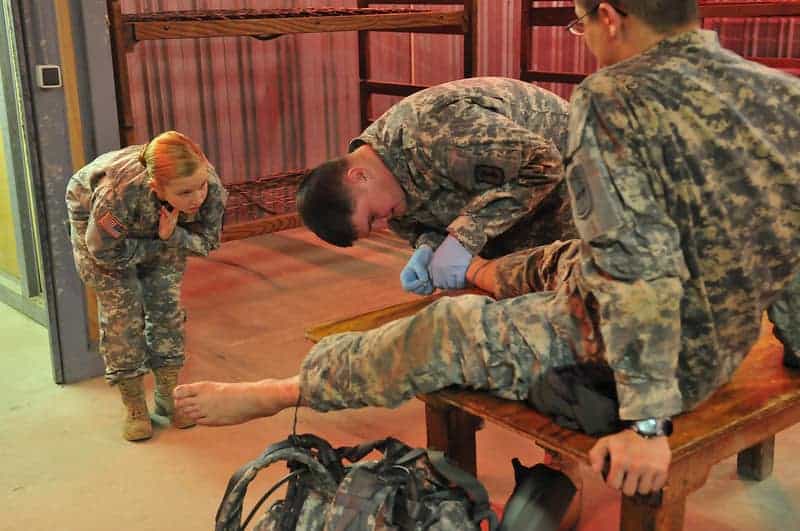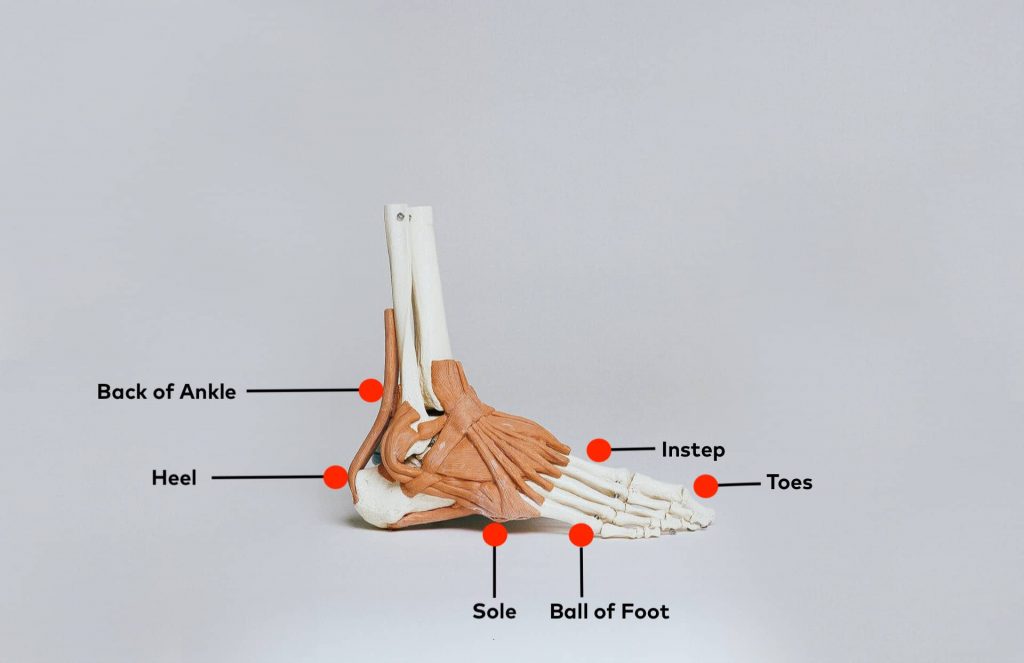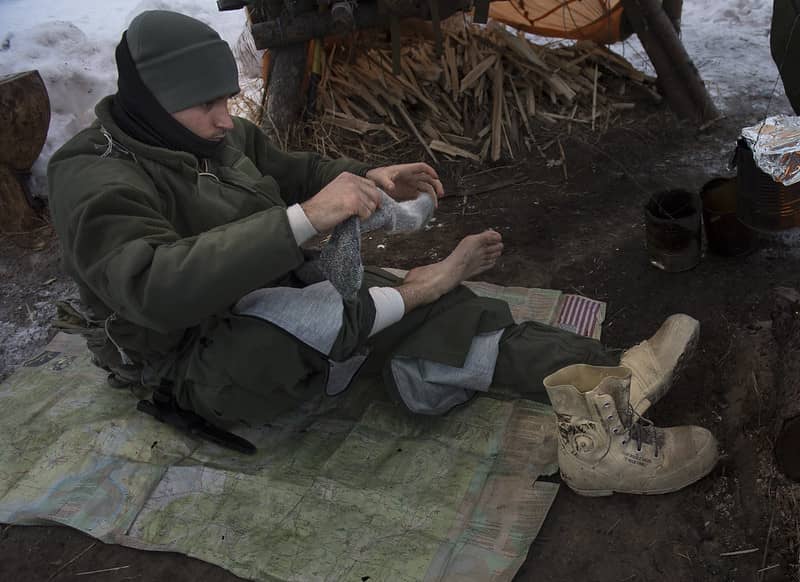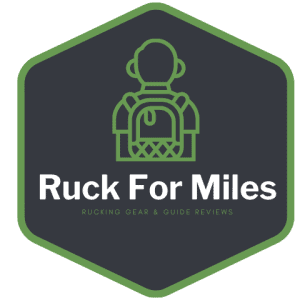
Avoiding blisters from ruck marching is a process that requires foot care before, during, and after the rucking session. Some people are more prone to blisters than others which sheds light on the importance of knowing how to avoid blisters from rucking.
If you’ve ever rucked before, you know how frustrating, uncomfortable, and sometimes painful it is to keep on walking with a blister on your foot. However, in the world of rucking, getting those blisters is unavoidable.
Sometimes we’re not able to avoid blisters but we can definitely manage them and prevent more of them from forming.
What are Blisters?
A blister is a bubble or small pocket of fluid that forms on any area of the body (source). The clear and liquid substance inside of the blister is called serum (source). If the blister is left and undamaged, the serum protects the skin beneath it.
During ruck marches, the most common blisters are found on the feet. This is because rucking typically involves you walking for extended periods of time and neglecting foot care is the recipe for the perfect blister.
What Causes Blisters During Ruck Marching?
Rucking can lead to blisters forming on your feet because the feet eventually start heating up, which results in them sweating and building up moisture, which clogs the pores in your feet (source).
If you’re ruck marching in the military, the general standard is that you complete a 12 mile ruck march in 3 hours. For some, that is super quick. If you’re in that camp and have not worked out much before or are new to rucking, your feet may be susceptible to sweat more than usual which is likely to result in blisters forming.
Every day ruckers are also susceptible to blisters and they are bound to happen due to numerous factors which include and are not limited to:
- Wet feet
- New boots
- Boot Size
- Wearing the Wrong Boots
- Not Wearing the Right Socks
Learn more about how to toughen your feet for ruck marching to avoid foot pain during rucks.
Wet Feet
The build up of sweat and moisture is bound to happen when you’re rucking. You’re carrying a heavy backpack and marching for hours, this translates to sweaty and wet feet. The constant clogging of the sweat pores and exposure to damped environment surrounding your feet causes the build up of those nasty blisters.
New Boots
This is one of the most common cause of ruck march blisters. When you’re wearing your brand new boots, they’re not really expanded or shaped to your feet yet, which may make them feel too tight at times. This constant friction between your foot and boots ultimately leads to blisters forming.
Solution
- Wear your new boots frequently, but not for too long.
- Wear the thickest socks you have (again, don’t wear the new boots for too long)
- Blister hotspots should be clearly visible once you’ve worn your new boots for some time – Place a band aid to cover those blister hot spots moving onwards
- Bring your old boots with you on the ruck so that you can switch to your blister free boots
- Don’t lace your boots too tight – Skip an eyelet or two when tying up your boots, that will give your foot more space to move around and stretch out your new boots
Boot Size
Friction blisters are common when people wear boots that are the wrong size. The goal is to wear boots that are tight in the heel area (so that its not moving back and forth) while giving some room for your toes to move a little bit.
Solution
If your boots are too big, your feet will slide in all directions which leads to constant friction and rubbing, which results in blisters. Here are some tips on finding the right sized boots.
- Wear the same type of socks when trying different boot sizes.
- Try wearing your boots in the afternoon since your feet expand with use during the day (source).
- Try the boots on and push your thumb in the toe area. Make sure there is about a half-inch of space between the longest toe and the end of the boot. (source).
- Focus on width – If the ball of your foot feels too tight when you fully tie up your boots, go for a half-size bigger (source).
Wearing the Wrong Boots
A lot of boots in the market claim to be made for ruck marching yet they do not have the right features. We’ve reviewed a lot of proper rucking boots on RUCKFORMILES but here’s three main features to look out for in rucking boots to avoid blisters:
- Breathability – Breathable boots typically have mesh material, or outlets that allow for air circulation. The Altama Foxound SR8′ boots, Garmont T8 Bifida Tactical Boot , and the Belleville 390 DES Boots are examples of boots that are designed with breathability as a main priority.
- Waterproofing – As previously mentioned, wet feet equals blisters when ruck marching. Waterproof boots prevents water from rain or puddles from finding its way inside your boots. You may want to check out the Merrell Moab 2 8″ Tactical Waterproof Boot Wide Men’s if you’re looking for waterproof boots. Learn more about rucking in the rain.
- Proper insoles – when wearing your boots, you don’t want to have too much space between the top of your foot and the boot itself. If you feel like there’s too much space between your foot and the ceiling of the boot, try wearing a proper boot insoles to fill the gap.
Not Wearing The Right Socks
This one speaks for itself but you’d be shocked by how often people find a blister after a ruck march solely because of the socks they were wearing. Some people recommend wearing two socks if you’re prone to blisters.
The rationale behind the two-layer approach is that the second sock absorbs any friction or rubbing between the socks that are wrapped around your feet and the boot itself.
While the logic of that does make sense, we’re not sure how comfortable that would be and honestly have no personal experience with it. What we recommend is wearing socks made from merino wool. Here are a few reasons why:
- Merino Wool is Temperature regulating – This means that when you’re ruck marching in colder climates , merino wool acts as an insulator, trapping heat and keeping your foot warm and dry. They do this because the fiber bends and traps the air which helps to preserve the heat. On the other side of the spectrum, when rucking in hot climates, it absorbs the moisture and pushes out the sweat away from your feet. This keeps your feet dry and blister free.
- Merino wool is breathable
- Merino wool is Antimicrobial
Check out the best socks for rucking.
What To Do Before Ruck Marching To Prevent Blisters
Here’s a checklist of things to do before a ruck march to prevent blisters
1- Trim Your Toe Nails
Trimming your toe nails is key to avoid having the tall (and occasionally sharp) toe nails from stabbing your other toes during your ruck march!
Furthermore, trimming your toe-nails prevents toenail and toe tip blisters. Disgusting, right? Well here’s a summary of what those mean.
- A Toenail Blister is a blister that is formed under or around the toenail. This is caused by long toenails constantly stubbing your toe or having the foot move forward too far forward in the boot (source).
- A Toe Tip Blister is a blister caused by clawed toes (toes that bend inwards) with weighted pressure on the tip of the toe (source).
2- Use Anti Blister Balm
As discussed, blisters during ruck marches are caused by constant friction between the skin and the boot constantly rubbing. Anti Blister balm works by forming an invisible barrier between the skin and whatever rubs against it (in our case, its the boot).
The formula in the anti blister balm protects your feet against blisters.
Here’s are some common blister hot spot areas that you should rub the anti blister balm on (source):
- Back of the Ankle
- Heel
- Sole
- Ball of the Foot
- Toes
- Instep

Alternatively, you can choose to use Anti Blister Powder (link to Amazon).
3- Use Proper Gear
Boots
Wearing the right rucking boots for the march is key to preventing ruck march blisters. Wear boots that match the environment or climate that you will be ruck marching in.
For example, if you’re rucking in the winter or cold climates, then you may want to consider wearing the Garmont T8 Extreme GTX boots. Why? Well its great for insulation thanks to its GORE-TEX technology (which keeps your feet warm but breathable simultaneously). This prevents frostbites which is a possible cause of blisters on the feet during ruck marches (source).
The Garmont T8 GTX boots are also waterproof which is great for keeping your feet dry. If you’re ruck marching in the heat, then you may want to look at the Danner Tachyon 8 inch Tactical Boots since its features are primarily designed for the desert heat and focuses on breathability (which ensures your feet are dry and blister free).
Socks
Wearing Merino wool socks ensure that your feet are sweat and moisture free. It keeps your feet warm during the colder months and it keeps them cool during the summer months.
We do recommend getting the Fox River Military Mid Calf Boot Sock (link to Amazon).
Boot Insoles
Boot insoles ensure that your feet are well supported during a ruck march. It closes potentially large gaps in your boots (the space between the top of your foot (Instep) and the ceiling of the inside of the boot).
Check out the best boot insoles for rucking.
4- Bring Your Old Boots
If you’re using brand new boots for a ruck march and have the option to pack a pair of older rucking boots, we highly recommend doing so. It takes times to break into your new boots.
According to Gear Patrol, it takes roughly 80 to 100 hours of wear to properly break into your new boots (source). With that said though we do understand that 80 hours is too long of a time period so we’d suggest aiming for that benchmark before wearing your new rucking boots daily.
What To Do During A Ruck March To Prevent Blisters
Examine your feet during the ruck march and check for any hotspots where you believe the blisters will start to form. If you do find some of these spots on your feet starting to get irritated, consider changing your socks and applying blister powder or anti-blister balm for added protection.
Change Socks

Some people are prone to sweat more than others. Therefore, if you have the chance to take a short break during your ruck march, changing your socks will ensure that your feet are dry which will prevent blisters forming.
Apply Anti-Blister Balm or Blister Powder
Dry your feet and apply anti-blister balm (link to Amazon) or anti-blister powder on the blister hotspots. This will add a layer of invisible protection between the skin and the socks/boots.
Some people even choose to use antiperspirant deodorant as a substitute to stop the sweating. While we haven’t personally tried that, we’d recommend it if its the only thing you have packed.
What To Do After Ruck Marching To Prevent Blisters
Do Not Pop Your Blisters After A Ruck March
Rule number 1, try not to pop your blister! Your body heals itself in many ways and it does so even with blisters. This is because the serum (the clear liquid under the blister) keeps the skin under the blister clean. This prevents potential infections and enhances natural healing (source).
Manage and treat unpopped blisters by covering blisters with bandage
Apply a band aid over the blister, loosely. Keep some space between the top of the blister and the band-aid. If the blister is on a spot that is in a pressure area, use padding. See the video below by the American Academy of Dermatology showing you how to do apply it properly.
Other ways of treating an unpopped blister from ruck marching include (source):
- Vaseline – applying vaseline and covering the blister with a bandaid is a favorite approach among dermatologists (source).
- Aloe Vera – A systematic review showed that the compounds inside aloe vera gel reduces inflammation which promotes wound healing. However, there is no guarantee that it treats friction blisters. It’s just a low risk approach that may be worth trying (source).
How To Treat (and pop) A Blister From Ruck Marching
Sometimes popping a blister is unavoidable. This could be because its on a pressure area (i.e the sole of the foot). It could also be the case that it just hurts too much that you need to pop it. Remember, only pop a blister should you really need to!
How to Properly Pop A blister After a Ruck March
- Sterilize a small needle using Rubbing Alcohol
- Use the needle to pierce one edge of the blister (preferably the side that is away from you to allow the liquid to drain properly on the tissue/coton) – this just avoids creating a mess.
- Wash your hands properly and then wash the area with soap and water.
- Apply petroleum jelly (Don’t remove the skin of the blister).
- Cover area with bandage (source)
In case you don’t have everything you need at home, here’s a blister kit to help you get the job done.
Here’s a visual illustration on how to properly pop a blister by the American Academy of Dermatology.
Infected Blisters
Blisters are common when ruck marching, which raises the potential risk of being exposed to infected blisters. If blisters are left unattended to, bacteria or fungal infection starts developing in the infected area and may spread to other areas (source).
Infected blisters are typically painful and can be dangerous if left untreated. Seek medical attention if you believe that your blister(s) are infected, here’s a list of symptoms to look out for (source):






